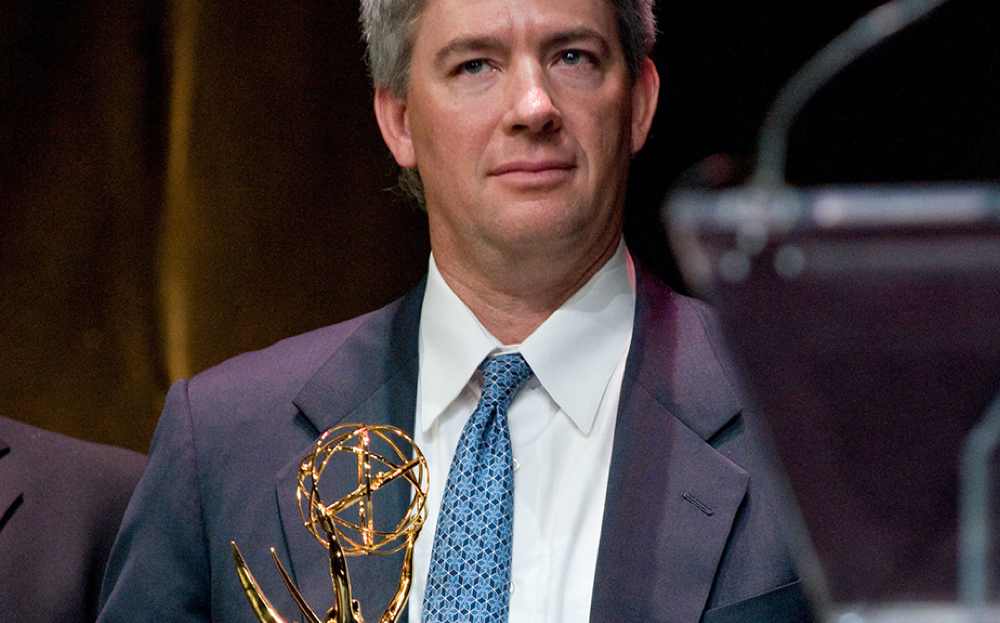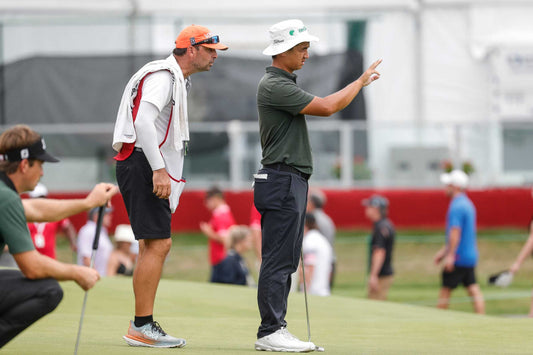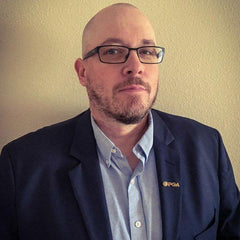Image credit: © Kimberly P. Mitchell / USA TODAY NETWORK
When Mark Sweeney appeared on the Quiet Please Golf Podcast in October 2023, he shared the story of how his own terrible putting led to one of golf's biggest technological breakthroughs. As a co-host of the podcast alongside Allen DePuy, Bob Baldassari, Christian Nizamis, and Andy Hydorn, I've had the chance to speak with many interesting people in the game over the years.
Andy and I hosted this particular episode to explore Sweeney's journey. Twenty years after founding AimPoint Golf, his green-reading system is everywhere on professional tours, completely changing how players approach the most important aspect of scoring.
From Personal Struggle to Emmy Award

Mark Sweeney won an Emmy in 2008 for his work on AimPoint. Credit: AimPointGolf.com
Sweeney's journey started with a basic problem: he couldn't make putts outside five feet. "Nobody could help me," he recalled on the podcast. "I went to pros and they were like, 'Oh, just putt a lot and you'll get better.' And I was like, 'Yeah, it's not working.'"
The turning point came when Sweeney, who had a background in software development, asked what seemed like a simple question: "How much does a 10-foot putt break?" The golf industry's answer at the time was that it was impossible to predict. "Everybody in the industry in 2003 was saying it's impossible to predict break," Sweeney explained. "There are too many factors you can't control, like wind and spike marks and divots."
Sweeney didn't accept that answer. He began writing software to solve the problem. The results were better than he expected. His technology eventually earned him an Emmy Award in 2008 for the George Wensel Technical Achievement Award. His virtual putting lines appeared on Golf Channel broadcasts for six years, covering thousands of live putts with surprising accuracy.
The Evolution to Express Read
AimPoint went through four major evolutions before arriving at its current form. The original system, called "breaklines," was highly technical and could take six months to master. "It was PhD green reading," Sweeney admitted.
The breakthrough came by accident while teaching seven and eight-year-olds. He couldn't use the complex angle-based system with children who hadn't learned geometry yet, so Sweeney improvised by having them hold up their thumb on the high side of the hole. When that wasn't enough for steeper slopes, he discovered that holding up one finger for every percent of side tilt worked incredibly well.
"Even this week, somebody asked (a tour player asked) 'It just doesn't make sense. Why does one finger match one percent?'" Sweeney said. While he couldn't initially explain why it worked, the results were clear. When mini-tour players who had used the old system tried the new method, they all preferred it, even though it was technically less accurate on paper.
The validation came in January 2014. Brian Gay used the Express Read method and shot the course record at Kapalua. "That, to me, was the moment where I went, 'This is the way we're going,'" Sweeney recalled.
The Physics of Breaking Putts
One of the most surprising findings from AimPoint challenges what most golfers believe about when putts break most. Many golfers think putts break primarily at the end when the ball slows down. Sweeney explained that while this looks true when measuring distance, it's misleading when considering time.
"If you look at it as a function of the last one foot versus the first one foot, yes, the last one foot breaks more than the first one foot," he explained. "If you look at it as a function of time (first one second versus the last one second) it's the same."
The key insight is that gravity affects the ball equally throughout the entire putt. The math shows that the biggest slope in the middle third of the putt dictates the break. "By the time you're three feet from the hole, the putt's over," Sweeney noted.
The Augusta National Connection
Sweeney's first paying customer was Augusta National Golf Club. That might surprise people. For 15 years, he's helped the club simulate pin placements to ensure fair but challenging setups. "They are one tournament where you will never see a bad pin," he observed.
The guideline is simple but effective: never put a pin on a slope over three percent. "It's not a rule, it's a guideline," Sweeney clarified. "But you can technically put a pin anywhere you want, and you'll get golf courses that stick it in five or six percent slope, and it's completely unplayable."
Professional Success and Adoption

Zecheng Dou lines up using the AimPoint technique before putting on the 18th green during the third round of the Rocket Mortgage Classic at Detroit Golf Club in Detroit on Saturday, July 1, 2023
Today, AimPoint's impact on professional golf is obvious. According to the podcast, 50% of PGA Tour winners use the system, along with half of the world's top 20 players. Seven world number ones have worked with Sweeney, including major champions and Olympic medalists.
The first tour player to adopt AimPoint was Scott McCarron in 2005. "He was the first one on tour," Sweeney said. "He learned it, went to top 10 in putting immediately from ranked 180 or so his whole career." Sweeney credits McCarron with giving him a chance when others were skeptical, calling him "a very appreciative golfer long-term."
The Importance of Proper Training
Despite AimPoint's widespread visibility, Sweeney estimates that 80% of people attempting to use it (even on television) aren't doing it correctly. His advice for golfers interested in learning the system is straightforward: find a certified instructor through AimPointGolf.com.
"If you don't learn it correctly, you're going to make a lot of mistakes and not understand why," he cautioned. "If you're going to learn it right, find a certified instructor and learn the proper way to do it."
Twenty years after Sweeney began his quest to answer a simple question about break, AimPoint has transformed from a personal project into an industry standard. It proves that sometimes the most significant innovations come from refusing to accept "impossible" as an answer.





